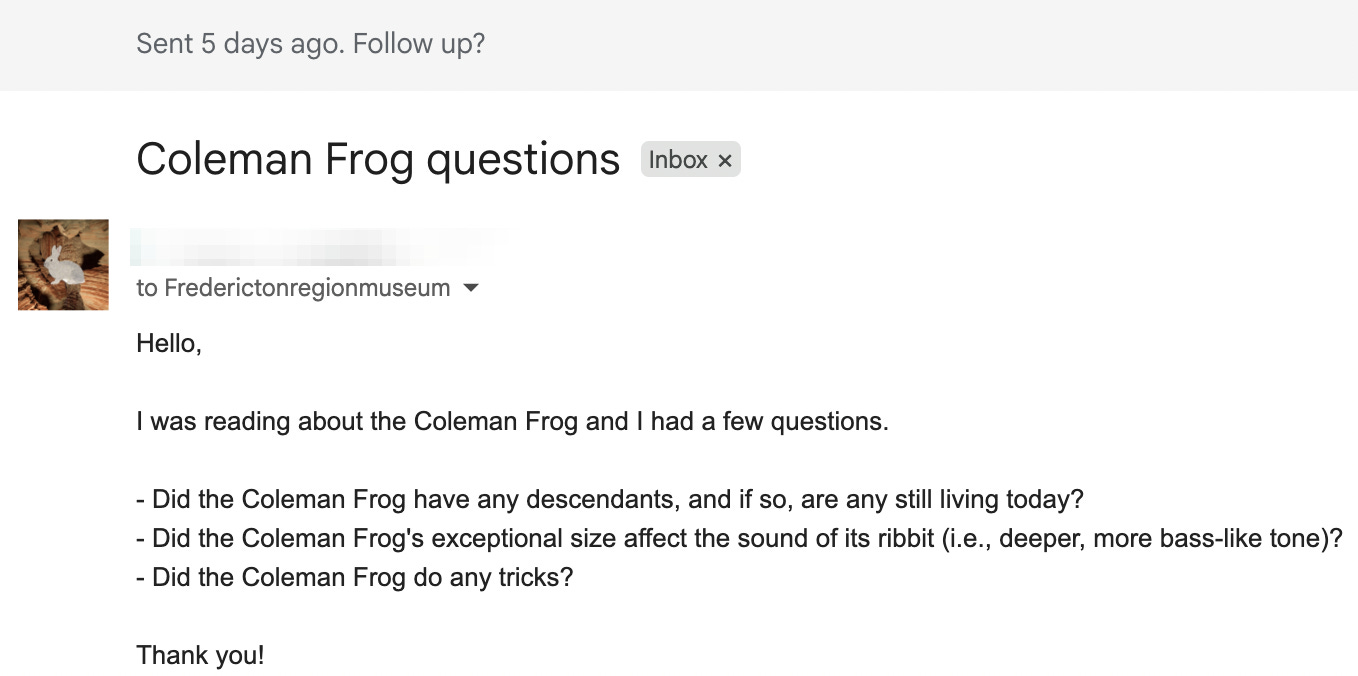Do you have a favorite frog? Well, you’re about to. Meet the Coleman Frog. (Also known as “Cornelia Webster” (see: “the mystery of the Coleman Frog’s gender identity”)
This frog is awesome. (This frog is also definitely 1000% a hoax – I just wanted to forewarn you so you don’t get all excited thinking that everything I’m about to tell you about this frog is real, genuine stuff. It’s all lies.)
As the story goes, Fred Coleman was out fishing one day in 1889 when a frog jumped into his boat – and buddy, this frog was huge. It allegedly weighed 7 pounds (a bit over 3 kg), which is a lot for a frog (trust me).
Fred was so impressed with the frog that he brought it back home to show all his friends. And afterwards, Fred said to the frog, “You know what? I like you. I’m gonna feed you.”
So Fred (allegedly) fed the frog “whiskey, baked beans, June bugs, buttermilk toddies, and whey.” This S-tier diet caused to frog to balloon in size, growing to an unbelievable 42 pounds (19 kg).
The Coleman Frog loved what Fred was feeding it, so much so that “the frog would come when called or to a dinner bell and entertained Fred’s guests.”
Unfortunately, the Coleman Frog was not long for this Earth and was killed in an unspecified “dynamite accident.” After its death, the Coleman Frog was taxidermied and is today on display in New Brunswick, Canada, at the Fredericton Region Museum, whose staff understandably ignored my emailed questions about the frog.
Coleman Frog skeptics allege the creature was invented to promote a cough syrup that would “relieve the frog in your throat” but the museum maintains that it’s definitely real, trust me bro, but refuses to allow DNA testing on the frog because “we're reluctant to disturb the peace of a stuffed beast that's been around quite happily for 123 years now.”
Is the Coleman Frog taxidermy at least a convincing fake? Ummm I’ll let you be the judge of that.
Apparently, it used to look a lot more realistic, but “after Fred passed away the glass cover came off the case and the Coleman Frog was used as an ashtray for inebriated hotel patrons.” Only after being “repaired” did it attain the artificial appearance it has today. Because it was definitely a real frog with real frog skin, remember? It’s not just canvas, wax, and paint, okay?

Anyway, the actual largest living frog is the goliath frog (also known as the giant slippery frog) which has been recorded weighing as much as 7.3 pounds (3.3 kg).
The largest frog ever known to have lived is the Beelzebufo, also known as the “devil frog,” also known as the “frog from hell,” coming in at an impressive 9 pounds (4 kg).
The devil frog lived about 70 million years ago in Madagascar and was “the size of a bowling ball” or a “squashed beach ball.” Do these scientists have any points of reference that are not balls?
This frog from hell had a giant mouth and may have even eaten “hatchling or juvenile dinosaurs.” It’s said that it had “short legs and a big mouth,” which sounds like a lot of toddlers I know.

This artist’s impression of our beloved devil frog was shared in a BBC article, and I thought it was hilarious, but then I found the full version which is even funnier:
Why the hell did the BBC crop it all zoomed in on its face? Explain yourself BBC?
The devil frog’s modern relatives include the South American horned frog, also known as the Pacman frog for its enormous mouth.
These frogs are awesome. They can easily eat a full-grown rat and have even been known to eat their mates, even if they are larger than them.
Sometimes Pacman frogs get too big for their britches and try to eat something that is simply too large to be eaten, and they choke to death because they have a hard time releasing their prey from their mouths. Oops!
One more Very Large Frog I want to share is the Loveland frog. This is a “legendary humanoid frog” from Ohio that was allegedly first spotted in 1955. This bad boy was described as being 4 feet tall (1.2 m). Wow! (No real frog has ever been that tall.)

In 1972, a police officer was out on patrol when he thought he saw the Loveland frog, so naturally, he shot and killed it. After recovering the body, he discovered it was just a large iguana with its tail missing – most likely someone’s pet that got loose, seeing as iguanas are (shockingly) not native to southwest Ohio.
Long live the Loveland frog! Moving on –
ARMED WITH CLAWS, FILLED WITH PISS
My second favorite frog is the African clawed frog, partially because it has claws, and partially because this frog was the key to the world’s first widely used pregnancy test.
Once upon a time in the 1930s, researchers accidentally discovered that if you injected a woman’s pee into this frog’s back, and the frog laid eggs within 18 hours, it meant the woman was pregnant.

Sounds insane, right? Well, it worked! This testing method was reported to have a 99% accuracy rate, and it was the best way we knew how to test for pregnancy all the way until the 1960s.
Tens of thousands of frogs were exported all across the globe and injected with pee during this time.
I just want to take a second to let it sink in that for thirty years – for the entire duration of World War II and then some – the frog piss method was the foremost way of determining whether someone was pregnant. Empires rose and fell, tens of millions of soldiers and civilians lost their lives, fascism was defeated in Europe – and all the while, numerous frogs around the world were being filled with piss.
These frogs could be reused, so scientists were just injecting them with urine again and again. How do you think the frogs felt about this whole arrangement?
African clawed frogs can live in captivity for up to 30 years, so it is entirely conceivable that there was a frog born in 1930 that spent its entire time on this Earth being injected with piss over and over again until it died of natural causes.
Also, these frogs routinely shed and then eat their own skin, so this hypothetical frog of ours would have been eating its own piss skin for three decades in the name of reproductive healthcare.
These frog tests are obviously no longer used in practice today, but sometimes they are replicated for educational demonstrations. Some people have mixed feelings on this – see: “Why I fought a pregnant lady to steal a frog.”
One small drawback of sending these frogs all over the world for pregnancy tests is that it may have led to the spread of a catastrophic fungal disease that has devastated global amphibian populations. Oops!
So, how did we test for pregnancy before someone thought to inject frogs with pee? I’m glad you asked! We injected mice and rabbits with pee.
Turns out we used to love injecting animals with pee to figure out if women were pregnant. It’s piss-filled animals all the way down. There’s a whole Wikipedia page about pregnancy tests using animals. Who knew?
The rabbit tests were a little more complicated. Instead of the quick and simple turnaround that the frog test offered, rabbits had to be injected with urine twice a day for three days in a row before being killed and dissected to see if the urine had caused their ovaries to become enlarged, which indicated a positive pregnancy.
This gave rise to a popular euphemism, “the rabbit died,” to say that a woman was pregnant. However, the euphemism was inaccurate because the rabbit died either way. Sorry rabbit!
Anyway, back to the African clawed frog. Our little froggy friend loves science, as it turns out. Beyond the pregnancy test stuff, it also became the first vertebrate to be cloned in 1962, beating out Dolly the sheep by over 30 years.
This frog also went to space on the same Space Shuttle mission that carried Mae Jemison, the first Black woman in space; Mamoru Mohri, the first Japanese astronaut; and Mark Lee and Jan Davis, the first married couple to travel to space together.
(This was not the first time we sent frogs to space)
I absolutely love stumbling upon wild stuff like the piss frogs because it beautifully captures everything about the exquisite joy of learning that drives me to write this blog in the first place.
Like… for as long as I’ve been alive, it’s always been true that we used to inject frogs with pee to determine whether someone was pregnant. That piece of information has always been floating inconspicuously in the background. I’ve grown from child to adult, graduated from college, and built a life I’m proud of, and all the while the piss frogs have been there, silently lurking just beyond the periphery of my knowledge.
It didn’t just become true the moment I read about it on Wikipedia. It’s always been there, waiting for me to discover it, and it somehow took me a quarter of a century to do so. And the moment you find that elusive piece of knowledge, it feels like you’ve had your eyes opened to a hidden world lying just beneath the surface. Frogs have always been injected with piss? Gerbils have always had tons of seizures? Baseballs have always been hand-stitched?
There’s just so much information that’s hiding slightly out of view that is just waiting to be found out by us. And when you shine a light on it, your world becomes fuller. You become a more complete person. That’s why I love learning. With each new piece of information, you broaden your understanding of the world bit by bit, you add another piece to the never-ending puzzle of the quest for knowledge, and you become more connected with the world you inhabit, all the people you share it with, and all the people who have stewarded it along the way.
And you know what? I really came across the whole “piss frog” thing by accident. It was so far from front and center in my journey through Frog Wikipedia, which I spent six straight hours foraging through. It often happens just like this that the most interesting thing I get to share in a post is the very last thing I stumble across when I’m “just gonna check one more thing real quick” before I wrap up my research and begin writing.
It started with the “Category:Prehistoric frogs” page which I was honestly not excited to read, but I felt obligated to leave no stone unturned. Then I clicked “Singidella” (an extinct genus of frog) and read that it was “closely related to the extant African dwarf frogs,” and then I saw on the dwarf frogs page that they are “often mistaken for the African clawed frog.” And even once I arrived at the clawed frog page, the whole thing about them being an integral part of the history of pregnancy testing was not prominently featured at all. You really had to dig to find it, which made it all the more satisfying when I uncovered this.
Anyway, you’re welcome for being enlightened to the exceptional intersection of wildlife and human urine. Next time you see a frog, give it a hearty thank you and whatever you do, do NOT pee on it.
MORE FROGS
Pinocchio frog (not to be confused with the long-snouted frog)
Some frogs are opposites
We have the masked frog and the revealed frog
Slender bleating tree frog and robust bleating tree frog
Our robust frog “has one of the loudest calls of any Australian frog, and it’s been described as almost painful to listen to - sounding like an incredibly loud, high-pitched screech.”
There’s Tyler’s tree frog, which is honestly not that interesting of a frog but I mention it here as a special shoutout to my friend Tyler (thanks for reading Tyler)
Thick anus tree frog (real)
Marvelous frogs (tbh they look pretty average to me, but what do I know)
Bird-voiced tree frog (pretty much exactly what it sounds like)
Named for its “raucous and explosive call”
“The calls of the barking tree frog sound like a church bell and have been described as ‘tonk’ and ‘doonk.’”
“About 90% of its range lies within Eglin Air Force Base”
…which is where the Mother of All Bombs was first tested, so yeah, this frog is doing great
Some frogs make these weird foam nests which make me very uncomfortable
Not a very impressive dance if you ask me
FROGS AT WAR
Okay, let’s wrap up today with an awesome frog story. Behold, the Battle of the Frogs.

Wikipedia helpfully describes this as “a frog-related incident,” which, yeah, I kinda figured.
It was the summer of 1754 in Windham, in what was then the Connecticut Colony. One summer night, the unsuspecting people of Windham were stirred awake in the middle of the night by a strange, cacophonous noise. They didn’t know where the noise was coming from, but the French and Indian War had just begun a few months prior, so they feared an impending attack.
An armed scouting party was sent out to investigate the noise, and do you wanna guess what they found? Frogs, obviously. They found frogs.
By the time morning rolled around, hundreds to thousands of dead frogs littered the outskirts of town. (Important clarification: the scouting party did not kill the frogs – the frogs killed the frogs.)
I’m no war historian, but I gotta think that this puts the Battle of the Frogs among the top ten deadliest battles of the French and Indian War. Feel free to chime in, war historians and also anyone else who wants to blindly speculate with me.
Some townspeople thought the frog noises sounded like they were coming from above, and others thought they heard voices in the noise (supposedly threats against prominent local men).
And you know what? People freaked out. They thought the world was ending and it was all because the local frogs were way too loud that night.
Once word got out about the frog battle, “Windham became the laughing-stock of the colonies.” People would not let Windham live down the frog thing. And the people of Windham said, “You know what? Fuck it. Let’s embrace the frog thing.” And so they did, making the frog their town mascot and putting pictures of frogs on their town seal and on their money.

People from Windham also got made fun of wherever they went: “Indeed, the fame of it has been so extended, that a citizen of the town can hardly go so far from home but he will hear something about bull-frogs if his place of nativity is known.”
One lawyer from Windham was even met with ridicule when he arrived in Philadelphia to join the Second Continental Congress. He “was greeted with shouts of laughter; when alighting, he discovered the cause of merriment to be a monstrous bull-frog, dangling from the hinder part of his carriage, appended probably by some wag on his route.”
So why the hell did the frogs do that anyway? One frog expert who grew up in Windham has a theory: it was a hot summer, so the receding shoreline of the frog pond forced all the frogs together precisely when they were trying to get laid. This created a sort of sex-fueled frog mosh pit that produced what “must have been a God-awful noise.”
The Battle of the Frogs is commemorated today by the Frog Bridge.

The design was inspired in part by a suggestion from a resident who had just gotten back from Europe, sharing about “a bridge with dragons on each end that are supposed to wag their tails when a virgin walks over it.”
In response, the executive director of the local planning agency said, ''We'd like to create a similar urban legend, but with frogs — and probably not involving virgins.”
That’s all I’ve got on frogs this week! Thanks for reading, and please subscribe if you want more stuff like this in your inbox.
If you enjoyed this piece, consider tossing me a few bucks (I will spend it on snacks)










The utter DELIGHT this entire article gave me. I cackled out loud constantly. Brilliance, thank you for this GIFT.
Another great rabbit cavern, thank you for teaching us about frogs! 🐸